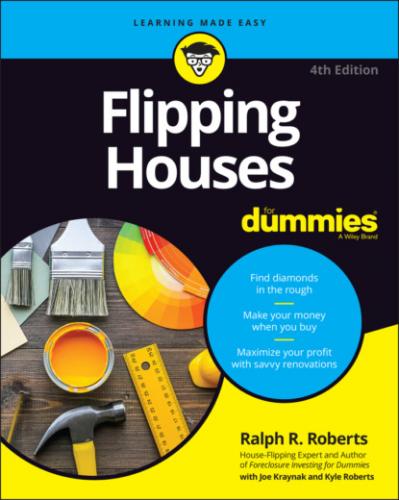Expanding your search on the Internet
You’ve probably seen those commercials in which a couple goes online to submit a request for quotes from various lenders. The lenders descend on the house like a flock of fawning suitors and grovel to win the couple’s favor. Funny, yes, but realistic? Not quite. You still need to perform your due diligence by checking the numbers, as I explain earlier in this chapter.
Borrowing for purchase and renovations with a renovation loan
Fannie Mae and the Federal Housing Authority (FHA) offer home renovation mortgage programs that enable qualified buyers to borrow an amount equal to what the property is expected to be worth after repairs and renovations. For example, if you can purchase a property for $90,000 and sell it for $120,000, you can borrow up to $120,000 to purchase the property and pay for the repairs and renovations.
To take advantage of a home renovation mortgage, you find a property to flip and then do a walk-through with your contractor (see Chapter 10) and come up with a list of repairs and renovations and their total estimated cost. You present the lender with the details, they order an appraisal, and if the appraised value of the property is greater than or equal to your total (purchase price plus cost of renovations) you get the loan, assuming you’re deemed creditworthy.
You use a portion of the loan to purchase the property, and the lender holds the rest of the money. For each repair or renovation, you obtain an estimate from a reputable contractor and then request a draw (a portion of the loan balance that the lender is holding) to be paid to the contractor. After the work is completed, a final inspection is conducted to ensure that all repairs have been made. Typically, you’re given about six months to complete the repairs and renovations.
Fannie Mae offers a home renovation mortgage that’s open to real estate investors. The FHA 203K renovation loan, on the other hand, is made available only for the purchase and renovation of an owner-occupied home; that is, you must live in the property for a full 12 months before selling it. You must apply for an FHA 203K loan through an FHA-approved lender. If this option is something you want to consider, discuss it with your mortgage broker.
Part 2
House Hunting with an Eye for Flipping
IN THIS PART …
Find and cultivate your farm area — a great neighborhood with plenty of good opportunities for flipping houses.
Discover dontwanners in your farm area — properties that are neglected because the owners don’t want them and are probably eager to sell.
Read foreclosure notices and notices of default (NODs) to find properties that you may be able to pick up at bargain prices.
Pick your point of entry in the foreclosure process: pre-foreclosure, foreclosure auction, or post-foreclosure (properties the banks repossess).
Avoid the most common and costly mistake novices make at foreclosure auctions. (This tip alone may save you more than $100,000!)
Capitalize on bargains in special markets, including divorce, bankruptcy, and probate.
Конец ознакомительного фрагмента.
Текст предоставлен ООО «ЛитРес».
Прочитайте эту книгу целиком, купив полную легальную версию на ЛитРес.
Безопасно оплатить книгу можно банковской картой Visa, MasterCard, Maestro, со счета мобильного телефона, с платежного терминала, в салоне МТС или Связной, через PayPal, WebMoney, Яндекс.Деньги, QIWI Кошелек, бонусными картами или другим удобным Вам способом.
